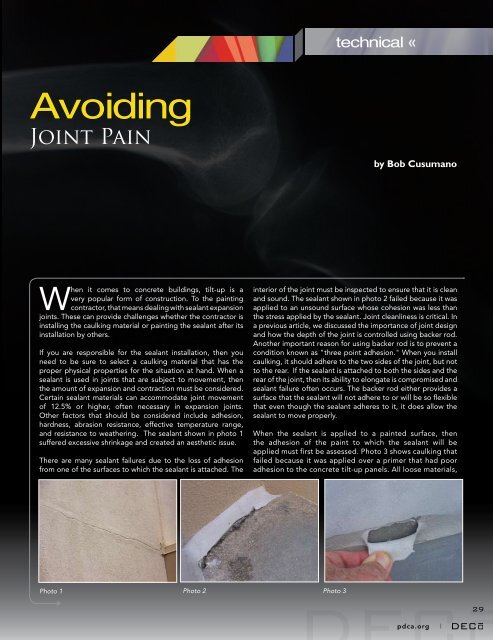n o v/d e c • 2 0 0 8 - Subscribe
n o v/d e c • 2 0 0 8 - Subscribe
n o v/d e c • 2 0 0 8 - Subscribe
You also want an ePaper? Increase the reach of your titles
YUMPU automatically turns print PDFs into web optimized ePapers that Google loves.
Avoiding<br />
Joint Pain<br />
When it comes to concrete buildings, tilt-up is a<br />
very popular form of construction. To the painting<br />
contractor, that means dealing with sealant expansion<br />
joints. These can provide challenges whether the contractor is<br />
installing the caulking material or painting the sealant after its<br />
installation by others.<br />
If you are responsible for the sealant installation, then you<br />
need to be sure to select a caulking material that has the<br />
proper physical properties for the situation at hand. When a<br />
sealant is used in joints that are subject to movement, then<br />
the amount of expansion and contraction must be considered.<br />
Certain sealant materials can accommodate joint movement<br />
of 12.5% or higher, often necessary in expansion joints.<br />
Other factors that should be considered include adhesion,<br />
hardness, abrasion resistance, effective temperature range,<br />
and resistance to weathering. The sealant shown in photo 1<br />
suffered excessive shrinkage and created an aesthetic issue.<br />
There are many sealant failures due to the loss of adhesion<br />
from one of the surfaces to which the sealant is attached. The<br />
Photo 1 Photo 2 Photo 3<br />
technical «<br />
by Bob Cusumano<br />
interior of the joint must be inspected to ensure that it is clean<br />
and sound. The sealant shown in photo 2 failed because it was<br />
applied to an unsound surface whose cohesion was less than<br />
the stress applied by the sealant. Joint cleanliness is critical. In<br />
a previous article, we discussed the importance of joint design<br />
and how the depth of the joint is controlled using backer rod.<br />
Another important reason for using backer rod is to prevent a<br />
condition known as "three point adhesion." When you install<br />
caulking, it should adhere to the two sides of the joint, but not<br />
to the rear. If the sealant is attached to both the sides and the<br />
rear of the joint, then its ability to elongate is compromised and<br />
sealant failure often occurs. The backer rod either provides a<br />
surface that the sealant will not adhere to or will be so flexible<br />
that even though the sealant adheres to it, it does allow the<br />
sealant to move properly.<br />
When the sealant is applied to a painted surface, then<br />
the adhesion of the paint to which the sealant will be<br />
applied must first be assessed. Photo 3 shows caulking that<br />
failed because it was applied over a primer that had poor<br />
adhesion to the concrete tilt-up panels. All loose materials,<br />
pdca.org |<br />
29








